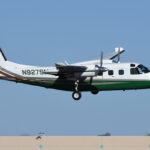By Barry Collman

The Model 690D, marketed as the “JetProp 900” was the twenty-eighth one to be placed into production, the first 18 by Gulfstream American Corporation, Commander Division at Bethany (Wiley Post Airport), Oklahoma City, Oklahoma; the next 11 by Gulfstream Aerospace Corporation, Commander Division, Bethany; and the last 13 by Gulfstream Aerospace Corporation, Commander Division, Oklahoma City.
The 42 examples were built between February 1982 and September 1985, serial numbers 15001 through 15042. Of these, 21 were initially certified in 1982; 13 in 1983; 2 in 1984; and 6 in 1985. Four examples of the 690D have been converted to Model 695A.
A factory document describes the Model 690D as “Certified December 2, 1981. Similar to the 690C. Differences include: a) increased ramp, take off, landing and zero fuel weights; b) increased fuel capacity from 425 to 430 gallons; c) higher certified altitude; d) increased design speeds; and e) redesigned fuselage.”
The Model 690D was indeed certified on December 2, 1981, under Type Certificate 2A4, with AiResearch TPE331-5-254K engines. The first 22 examples used the 106-inch diameter Dowty Rotol (c)R.306/3-82-F/7 / VP2926 ‘supercritical’ propellers (with a B.F. Goodrich deice kit); the next 12 used the (c)R.306/3-82-F/7 / VP3027 (with Dowty Rotol deice boots); and the last 8 used the (c)R.306/3-82-F/7 / VP3034.
Some have had TPE331-10T series engines installed under STC SA236CH.
Gross weight is 10,700 pounds and the cabin pressure differential is 6.7 psi, giving an 11,000-foot cabin at 37,857 feet and a sea level cabin at 15,909 feet.
Standard total fuel capacity is 430 U.S. gallons (1,628 litres), with 425 U.S. gallons (1,609 litres) usable. Optional total fuel capacity is 482 U.S. gallons (1,825 litres), with 474 U.S. gallons (1,794 litres) usable. These are the same capacities as on the Model 690C, so item b) “increased fuel capacity from 425 to 430 gallons” in the factory document mentioned above is an error.
All examples of the 690D featured a cosmetic dorsal fillet.
Like the Model 695A, the 690D also incorporated a major change to the fuselage, with the intention of maximising the cabin volume within the existing fuselage loft shape and length. Thus, the rear pressure bulkhead was moved aft approximately 36 inches and is under the wing torque box; the cabin aisle floor between the seats was lowered approximately four inches; the structural capability of the pressure vessel was increased from 5.2 to 6.7 psi; the fuselage vessel was pressurized completely to the lower skin (all previous pressurized Commanders were pressurized only to the floor level); and the picture window arrangement was deleted and replaced by four individual windows. This decision involved aesthetics, desire to improve cabin noise level, weight reduction and the increased pressurization level.

15033 – 690D-15033 – VP-BMZ
Additionally, the landing lights were moved back to the nose.
An optional version of the Model 690D featured a 45-inch-high by 45-inch-wide cargo/medevac “special missions” door on the starboard side of the fuselage.
On March 22, 2004 serial number 15013, as N42SL, had a Certificate of Airworthiness issued in the Experimental – To Show Compliance category, for collection of performance data applicable to the FAR requirement of RVSM (Reduced Vertical Separation Minimum), which reduces the vertical separation between Flight Levels 290 and 410 from 2,000 feet to 1,000 feet, and makes six additional flight levels available for operation.
Barry Collman’s lifelong interest in airplanes began when he was growing up in a house located underneath the downwind leg to busy Northolt aerodrome, an R.A.F. base near London-Heathrow airport. As a young teenager he discovered airplane “spotting”–hobbyists’ observation and logging of aircraft by make, model, and registration number. The hobby began to grow into a passion as Collman joined a club of like-minded spotters. At one point he purchased a copy of the January 1966 U.S. Civil Aircraft Register, and thumbing through it came upon the Aero Commander. He was hooked. Eventually he acquired every available FAA microfiche file on Commanders, and since 1995 has made annual pilgrimages to Oklahoma City to sift through FAA records. He now has a database with about 100,000 records as well as a collection of negatives, slides, photographs, digital images, magazines, brochures, knick-knacks–and a very understanding wife. This series on Commander production history originally was written for the Twin Commander Flight Group, of which he is an enthusiastic member.
N927SM
15013 – 690D-15013 – N927SM
A digital image, taken by Jarrod Wilkening on July 10, 2016, at Scottsdale, Arizona, N927SM is serial number 15013. Certificated as N5867N on July 30, 1982, it was used as a demonstrator by Gulfstream American until sold to the distributor, Skytel International Inc., of Fort Lauderdale, Florida on September 21, 1983. It became N900AB in June 1984, with Algernon Blair International Inc., then N42SL in September 1988, with Seiple Lithograph Company. Its current registration, N927SM, was completed in April 2005, for ShamMach Air LLC., and is currently owned by Hamm Equipment Inc., of Casper, Wyoming.
VP-BMZ
15033 – 690D-15033 – VP-BMZ
A digital image taken by Roger Syratt on March 6, 2008, at Turweston Aerodrome, Buckinghamshire, England, VP-BMZ is serial number 15033. Originally Certificated as N49GA on April 26, 1984, it was used as a demonstrator by Gulfstream Aerospace until sold in September 1984. In September 1989, it was sold to Marlborough Fine Art (London) Ltd. and was registered in the UK with the personalized mark G-MFAL. They then placed it in the Register of Bermuda as VR-BMZ before a change of prefix to VP-BMZ occurred in 1997, although the aircraft remained based in the UK. Also, in 1997, the original TPE331-5-254K engines were replaced with TPE331-10T series, as evidenced by the inscription on the nacelle, “Dash 10 Supreme Commander.” It was subsequently sold in the United States, becoming N900PW in June 2016, and is currently owned by ABF Aviation LLC., of Stephenville, Texas.
